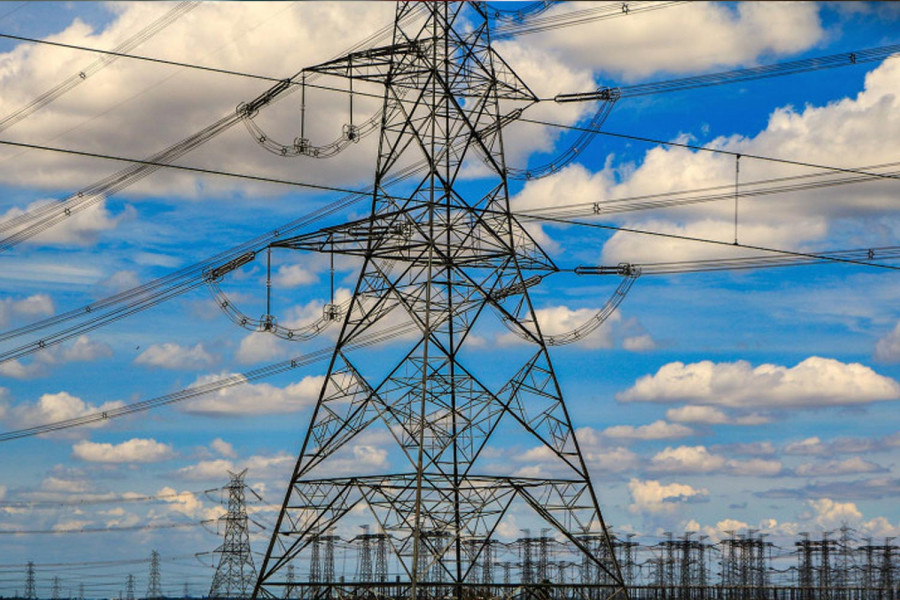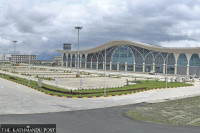National
Power delivery from Tamakoshi to Kathmandu unlikely soon
Locals have been obstructing the construction of the substation in Lapsephedi at a time when most of the works of the transmission line project have been completed.
Prithvi Man Shrestha
The 400kV Naya Khimti-Barhabise-Lapsephedi transmission line is almost complete but it is not certain when it will be fully completed amid continued obstruction by some locals at the construction site of a substation at Bojhini area of Shankarapur Municipality-3, Kathmandu.
It is the latest example of the difficulty the power utility has faced to construct the transmission line in the country after facing similar problems in many other projects in the past.
According to the Nepal Electricity Authority (NEA), it is a very important project that delivers power from the hydropower projects built in the Tamakoshi and Sunkoshi rivers and their tributary streams to the Kathmandu Valley, which is the country’s largest consumption centre of power.
For example, the 456MW Upper Tamakoshi Hydropower Limited, Nepal’s largest operating hydropower project currently, came into commercial operation in August 2021. But the NEA has not been able to supply its power to Kathmandu valley due to delays in completing this transmission line project.
Now, with locals’ obstruction continuing at the site of the proposed substation at Lapsephedi, it will take more time for NEA to deliver power from Upper Tamakoshi to Kathmandu Valley.
According to the state-owned power utility, the locals have been obstructing the works at the project site for the last two years demanding that the substation should not be built at the proposed location where there is a settlement of Tamang community.
As the power utility started a survey to build civil structures at the acquired 170 ropanis of land on Sunday last week, locals have been protesting against the construction of the substation.
Ward chairperson of the Shankarapur-3, Surya Bahadur Tamang, whom the NEA has blamed for leading the protest, said he was backing the protest as their representative. “The substation construction shouldn’t affect human settlement,” he told the Post.
As the protest has erupted at a time when the project is on the verge of completion, the future of the project remains uncertain. With locals not allowing the Indian contractor—Larsen and Toubro Limited—to work on the project, the NEA has already extended the contract till December-end 2023.
According to the NEA, the protest has been organised by people other than those whose lands were acquired. The utility said that it has already paid compensation to 49 out of 50 landowners since the acquisition of their lands in early 2018.
“Paying compensation to a single remaining land owner has been legally problematic as the land being utilised by the person has remained as abandoned government land,” the NEA said in a statement.
When the power utility first awarded a contract to a Chinese joint venture company in December 2017, there had been no local protests. After the new Indian contractor got the job in November 2020—after the contract with the first one was terminated due to slow work progress—the project is facing obstruction, according to the NEA.
“Rather than those whose lands were acquired, some locals around the area have been obstructing the substation construction by pushing forward local women,” the NEA said in a statement. The NEA has also blamed domestic and international non-government organisations for instigating the protest.
For example, some fringe political parties such as the Struggle Against Marginalisation of Nationalities and Nepal Tamang Dhedun have protested against substation plans, reminding that evicting the indigenous nationalities and local people would be against international conventions that Nepal is a party with.
But on Monday, the NEA made it clear that the location of the substation could not be changed as construction work moved ahead after completing all legal processes and contract processes. But it also made it clear that it was ready to listen to the ‘justified’ demands of the locals related to road maintenance and expansion, drinking water, school building, and monasteries.
NEA Managing Director Kul Man Ghising said that though the people whose lands were acquired have already received their compensation, people who had no relations with the acquired lands were instigating the locals against substation construction.
“As the project is being developed with the assistance of the Asian Development Bank, a donor agency, non-government organisations have also been involved as they always do against foreign-aided projects,” he said.
Certain local political leaders had made the issue of transferring the substation to other locations their election agenda. That’s why the issue has also been included in the budget and programme of the Shankarapur Municipality. “As the substation and the Tamakoshi Transmission line will affect the settlement of indigenous nationalities, a request will be made to take ahead the process of transferring the substation to other locations,” the budget and programme 2022-23 of the local government states.
An NEA official said that the current ward chairperson Tamang had made the issue one of the key election agendas and he is now leading the protests.
Tamang, however, claimed that the substation at the human settlement is being built without the informed consent of the local people. “They were emotionally blackmailed to acquire the land,” he said. “First, the government stopped buying and selling the lands of some locals without informing the locals. Then, other people were also notified that their lands also would not be allowed to sell and buy. Then, out of desperation, people accepted the compensation instead of being willing to give up their lands.”
With the political actors also being involved in the project’s dispute, it will be harder for the NEA to carry out the work of the substation further. Ghising said the ongoing obstruction could also affect the construction of upcoming substations in the Kathmandu Valley.
Projecting that there will be a demand for 3000MW of electricity in the Valley by 2050, the NEA has been expanding the 220kV transmission line around the Valley. “For this, 20 new substations need to be built inside the valley,” the NEA said in the statement. “If such obstruction continues, how are we to build other substations?” The NEA added that if new infrastructure is not allowed to be built, Kathmandu Valley could face load shedding once again.




 8.12°C Kathmandu
8.12°C Kathmandu















